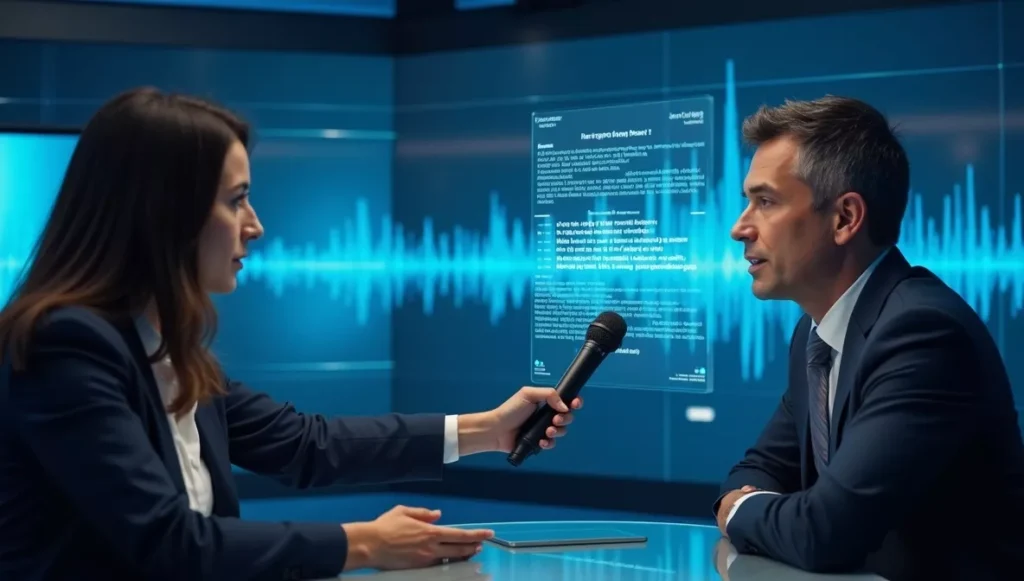Why Transcribing Interviews Used to Be a Nightmare
You just finished an amazing two-hour interview with an expert. Your notebook is full of scribbles, your recorder captured everything perfectly, and you’re excited to write your story. Then reality hits – you need to type out every single word. Every “um,” every pause, every brilliant quote.
- Why Transcribing Interviews Used to Be a Nightmare
- What Is AI Transcription and How Does It Work?
- The Simple Explanation
- What Makes AI Transcription Special?
- Why Journalists Need AI Transcription Tools
- 💖 You Might Also Like
- Time Is Everything in Newsrooms
- Accuracy Matters
- Perfect for Different Types of Journalism
- Why Researchers Love AI Transcription
- Handling Large Research Projects
- Better Analysis and Insights
- Ethics and Privacy
- ✨ More Stories for You
- The Best AI Transcription Tools: A Detailed Look
- 1. Otter.ai – The Journalist’s Best Friend
- 2. Rev.ai – When Accuracy Is Everything
- 3. Descript – The Video Journalist’s Dream
- 🌟 Don’t Miss These Posts
- 4. Trint – The International Reporter’s Choice
- 5. Sonix – The Academic Researcher’s Tool
- 6. Happy Scribe – The Budget-Friendly Option
- 7. Fireflies.ai – The Meeting Specialist
- 8. Speechmatics – The Accent Expert
- 9. AssemblyAI – The Developer’s Choice
- 10. Transkriptor – The Simple Solution
- Choosing the Right Tool for Your Specific Needs
- For Daily Newspaper Journalists
- For Investigative Reporters
- For Video and Documentary Journalists
- For Academic Researchers
- For Market Researchers
- For Student Journalists and Researchers
- For International Correspondents
- For Podcast Journalists
- For Freelance Journalists
- Key Features to Look For
- 1. Accuracy Rate
- 2. Speaker Identification
- 3. Timestamps
- 4. Language Support
- 5. File Format Support
- 6. Export Options
- 7. Security and Privacy
- 8. Editing Interface
- 9. Collaboration Features
- 10. Integration with Other Tools
- Tips for Getting the Best Transcription Results
- Before the Interview
- During the Interview
- After the Interview
- Special Situations
- Common Challenges and Solutions
- Challenge 1: Poor Accuracy
- Challenge 2: Wrong Names and Terms
- Challenge 3: Speaker Mix-ups
- Challenge 4: Missing Punctuation
- Challenge 5: Cost Concerns
- Challenge 6: Privacy and Confidentiality
- The Future of AI Transcription
- More Accurate Understanding
- Smarter Analysis
- Better Integration
- Real-Time Everything
- More Accessible
- Legal and Ethical Considerations
- Recording Consent
- Data Protection
- Source Protection
- Accuracy and Fairness
- Research Ethics
- Making the Most of Your Transcripts
- For Journalists
- For Researchers
- For Both
- Conclusion: Welcome to the Future of Interviews
- The Bottom Line
- Getting Started Today
- A Final Thought
- Frequently Asked Questions (FAQ)
- Q1: Is AI transcription really accurate enough for professional work?
- Q2: How much does AI transcription really cost?
- Q3: Can AI transcription handle multiple speakers?
- Q4: What about interviews in languages other than English?
- Q5: Is my data safe and private with these tools?
- Q6: Can I transcribe phone calls?
- Q7: How long does transcription take?
- Q8: What’s the difference between AI transcription and human transcription?
- Q9: Can transcription tools handle background noise?
- Q10: Do I need special equipment?
- Q11: What if the AI gets a name wrong?
- Q12: Can I transcribe video files?
- Q13: How do I transcribe Zoom meetings?
- Q14: What about accents and dialects?
- Q15: Can students use these tools for interviews and research?
- Q16: What if my interview is very long (2+ hours)?
- Q17: Do these tools work offline?
- Q18: Can I use transcription for YouTube videos or podcasts I didn’t create?
- Q19: What’s the best way to store and organize transcripts?
- Q20: How can I improve my interviewing technique to get better transcripts?
- Real-World Success Stories
- Success Story 1: The Investigative Reporter
- Success Story 2: The PhD Researcher
- Success Story 3: The Documentary Filmmaker
- Success Story 4: The Freelance Writer
- Success Story 5: The Market Research Team
- Advanced Tips and Tricks
- Tip 1: Create Custom Vocabularies
- Tip 2: Use Keyboard Shortcuts for Editing
- Tip 3: Batch Process Multiple Interviews
- Tip 4: Create Templates for Common Interview Types
- Tip 5: Use Time-Coded Notes
- Tip 6: Combine AI Transcription with AI Writing Assistants
- Tip 7: Create Searchable Archives
- Tip 8: Share Strategically with Sources
- Tip 9: Use Transcripts for Multiple Purposes
- Tip 10: Learn from Your Errors
For years, journalists and researchers dreaded this part. Typing out a one-hour interview could take four to six hours. Your fingers would hurt, your back would ache, and you’d hear the interviewee’s voice in your dreams.
But here’s the good news: Those days are over.
Thanks to artificial intelligence, transcribing interviews has become incredibly easy, fast, and accurate. In this guide, we’ll explore the best AI tools that can turn your recorded interviews into written text in minutes, not hours. Whether you’re a journalist chasing deadlines, a researcher analyzing data, or a student working on a project, there’s an AI tool perfect for your needs.
Let’s dive in and discover how these amazing tools can save you time and make your work so much easier!
What Is AI Transcription and How Does It Work?
Before we look at specific tools, let’s understand what AI transcription actually means.
The Simple Explanation
AI transcription is like having a super-fast typist who can listen to recordings and type everything out perfectly. But instead of a person, it’s a computer program powered by artificial intelligence.
Here’s how it works in simple steps:
- You upload your audio or video file to the AI tool
- The AI listens to the recording using special technology called speech recognition
- It converts the sounds into words by matching what it hears to words in its database
- It creates a written document with everything that was said
- You get your transcript ready to read, edit, and use
What Makes AI Transcription Special?
The magic happens because modern AI has been trained on millions of hours of human speech. It has learned to:
- Recognize different accents and speaking styles
- Understand context to choose the right words
- Identify different speakers in a conversation
- Handle background noise fairly well
- Process hours of audio in just minutes
Think of it like teaching a student. The more examples the AI sees and hears, the better it gets at understanding human speech. Today’s AI transcription tools are incredibly smart because they’ve been trained on so much data.
Why Journalists Need AI Transcription Tools
Journalism is all about speed and accuracy. Let’s see why AI transcription has become essential for modern journalists.
💖 You Might Also Like
Time Is Everything in Newsrooms
When you’re working on a breaking news story or trying to meet a deadline, every minute counts. AI transcription tools can:
- Transcribe a 60-minute interview in under 5 minutes instead of the 4-6 hours it takes manually
- Let you search for specific quotes instantly without listening to the entire recording again
- Help you work on multiple stories at once by transcribing interviews while you write
- Free up time for actual reporting and writing instead of typing
A newspaper reporter once said, “AI transcription gave me back my evenings.” Instead of staying late to transcribe interviews, she could now spend time following up on leads and developing sources.
Accuracy Matters
When you quote someone in a news article, you need to get their words exactly right. AI transcription helps by:
- Capturing every word spoken without the risk of mishearing
- Providing a permanent record you can refer back to
- Reducing human error that comes from tired ears and fingers
- Creating timestamps so you can verify quotes in the original recording
Perfect for Different Types of Journalism
Different journalists have different needs:
Investigative journalists often conduct dozens of interviews for a single story. AI transcription lets them organize and search through all these conversations efficiently.
Broadcast journalists can quickly create written versions of their TV or radio interviews for web articles.
Freelance journalists save money by not having to pay human transcriptionists, making their business more profitable.
Beat reporters can build searchable databases of their interviews, making it easy to find past quotes and information.
Why Researchers Love AI Transcription
Research work involves lots of interviews, focus groups, and recorded observations. AI transcription is a game-changer for academic and market researchers.
Handling Large Research Projects
Research projects often involve:
- Multiple interviews with many participants – imagine transcribing 50 interviews of an hour each!
- Focus group discussions where several people talk at once
- Longitudinal studies that track people over months or years
- International research with speakers in different languages
AI tools can handle all of this much faster than any human could.
Better Analysis and Insights
When your interviews are transcribed, you can:
- Use text analysis software to find patterns and themes
- Code your data more efficiently by highlighting and tagging sections
- Share transcripts with team members for collaborative analysis
- Create better reports with exact quotes from participants
A PhD student studying climate change attitudes said, “AI transcription turned my 100 interviews into a searchable database. I could find every mention of ‘renewable energy’ across all conversations in seconds. This would have been impossible before.”
Ethics and Privacy
Researchers also care deeply about:
- Confidentiality – keeping participant information secure
- Accuracy – representing what people said fairly
- Accessibility – making research available to people with hearing difficulties
Good AI transcription tools help with all these concerns by offering secure platforms, accurate transcripts, and text that can be read instead of only heard.
✨ More Stories for You
The Best AI Transcription Tools: A Detailed Look
Now let’s explore the top AI transcription tools available today. We’ll look at what makes each special and who they’re best for.
1. Otter.ai – The Journalist’s Best Friend
What It Is: Otter.ai is like having a smart assistant in every interview. It transcribes in real-time, meaning you can see words appearing on your screen as people speak.
Best Features:
- Real-time transcription – Watch the text appear as the interview happens
- Speaker identification – Automatically figures out who’s talking
- Mobile app – Record and transcribe directly from your phone
- Integration with Zoom – Perfect for remote interviews
- Highlights and notes – Mark important moments during recording
Perfect For:
- Journalists doing phone or video interviews
- Reporters who need quick turnaround
- Anyone conducting Zoom interviews
Pricing:
- Free plan: 600 minutes per month (about 10 hours)
- Pro plan: $16.99 per month for 6,000 minutes
- Business plan: $30 per month for teams
Real Story: Maria, a tech journalist, uses Otter.ai for all her product launch interviews. “I can focus completely on asking follow-up questions because I’m not worried about missing anything. The transcript is already there, searchable and ready.”
2. Rev.ai – When Accuracy Is Everything
What It Is: Rev offers both AI transcription and human transcription services. Their AI is known for exceptional accuracy.
Best Features:
- 99% accuracy on clear audio – Among the most accurate AI tools
- Fast turnaround – Get transcripts in minutes
- Multiple file formats – Supports almost any audio or video format
- Custom vocabulary – Teach it industry-specific terms
- Human backup option – Order human transcription when you need perfection
Perfect For:
- Investigative journalists who need extremely accurate quotes
- Legal interviews and depositions
- Academic research requiring high accuracy
- Anyone working with technical content
Pricing:
- AI transcription: $0.25 per minute of audio
- Human transcription: $1.50 per minute (takes longer)
Why It Stands Out: Rev’s AI has been trained on millions of hours of professional transcriptions. It’s especially good at handling different accents, technical terms, and challenging audio conditions.
3. Descript – The Video Journalist’s Dream
What It Is: Descript is more than a transcription tool—it’s a complete audio and video editing platform where you edit media by editing text.
Best Features:
- Edit audio by editing text – Delete words from the transcript and they disappear from the recording
- Overdub feature – Create realistic voice recordings for corrections
- Screen recording – Perfect for recording video calls
- Multi-track editing – Handle complex podcast or video projects
- Studio sound – AI improves audio quality
Perfect For:
- Video journalists and documentary makers
- Podcast journalists
- Content creators who need to edit and transcribe
- Anyone who wants to edit video without complicated software
Pricing:
🌟 Don’t Miss These Posts
- Free plan: One hour of transcription per month
- Creator plan: $15 per month for 10 hours
- Pro plan: $30 per month for 30 hours
Real Story: David, a documentary filmmaker, says, “I can turn a three-hour interview into a tight five-minute segment just by editing the transcript. It’s revolutionized my workflow.”
4. Trint – The International Reporter’s Choice
What It Is: Trint is designed specifically for journalists and researchers who work across languages and need collaboration features.
Best Features:
- 31+ languages supported – Transcribe interviews in multiple languages
- Interactive editor – Click on text to jump to that moment in the audio
- Verification mode – Makes checking accuracy super easy
- Team collaboration – Share and work on transcripts together
- Export to editing software – Works with Adobe Premiere and Final Cut
Perfect For:
- International correspondents
- Newsrooms with multiple reporters
- Multilingual research projects
- Teams needing to share and collaborate
Pricing:
- Starts at $52 per month for individuals
- Custom pricing for teams and organizations
Why Journalists Love It: Major news organizations like BBC, CNN, and The New York Times use Trint. It’s built specifically for journalism workflows.
5. Sonix – The Academic Researcher’s Tool
What It Is: Sonix is powerful AI transcription software with advanced analysis features perfect for research.
Best Features:
- 40+ languages – Truly global coverage
- Automated translation – Transcribe in one language, translate to another
- Advanced search – Find specific words or phrases across all transcripts
- Word cloud generation – Visualize frequently used terms
- Research-friendly exports – Export to formats used in research software
Perfect For:
- Academic researchers with qualitative data
- International research teams
- Multi-language focus groups
- Anyone analyzing large amounts of interview data
Pricing:
- $10 per hour of transcription (pay as you go)
- $22 per month for 5 hours
- $110 per month for 30 hours
Research Highlight: Dr. Sarah Johnson used Sonix for her sociology dissertation involving interviews in Spanish, English, and French. “Being able to transcribe and translate automatically saved me months of work and thousands of dollars.”
6. Happy Scribe – The Budget-Friendly Option
What It Is: Happy Scribe offers excellent transcription at competitive prices, with both AI and human options.
Best Features:
- 120+ languages – One of the widest language selections
- Subtitle creation – Automatically generate subtitles for videos
- Affordable pricing – Good quality at lower cost
- Simple interface – Easy to learn and use
- Quick turnaround – Fast processing times
Perfect For:
- Student journalists and researchers on tight budgets
- Independent content creators
- Anyone needing subtitles for video content
- International projects with uncommon languages
Pricing:
- AI transcription: Starting at $0.20 per minute
- Human transcription: Starting at $1.70 per minute
Student Success: Emma, a journalism student, says, “As someone on a student budget, Happy Scribe let me transcribe all my interviews without going broke. The quality is great for the price.”
7. Fireflies.ai – The Meeting Specialist
What It Is: Fireflies.ai is designed for recording and transcribing meetings, calls, and interviews conducted online.
Best Features:
- Automatic recording – Joins your video calls and records automatically
- Smart summaries – AI creates summaries of key points
- Action items tracking – Identifies tasks and follow-ups
- CRM integration – Connects with business tools
- Conversation analytics – Shows talk time, sentiment, and topics
Perfect For:
- Journalists conducting remote interviews
- Researchers doing virtual focus groups
- Anyone with lots of online meetings
- Teams wanting to track interview insights
Pricing:
- Free plan: 800 minutes per month
- Pro plan: $18 per month
- Business plan: $29 per month
Use Case: Tom, a business journalist, uses Fireflies.ai for all his CEO interviews over Zoom. “It automatically joins my calls, records everything, and gives me a transcript and summary. I can focus on the conversation instead of taking notes.”
8. Speechmatics – The Accent Expert
What It Is: Speechmatics specializes in understanding different accents and dialects better than most AI tools.
Best Features:
- Exceptional accent handling – Works with regional accents and dialects
- Real-time transcription – Live transcription available
- High accuracy – Among the best for challenging audio
- 50+ languages – Global coverage
- Secure and private – Strong data protection
Perfect For:
- Journalists interviewing people with strong accents
- International research projects
- Documentaries with diverse speakers
- Anyone prioritizing accuracy with varied speech patterns
Pricing:
- Custom pricing based on usage
- Free trial available
Why It Matters: When you’re interviewing someone with a thick Scottish accent, a farmer from rural India, or a street vendor in Mexico City, you need AI that can understand different ways of speaking. Speechmatics excels at this.
9. AssemblyAI – The Developer’s Choice
What It Is: AssemblyAI is a powerful transcription API that other software developers can build into their applications.
Best Features:
- State-of-the-art accuracy – Uses the latest AI technology
- Content moderation – Can detect and flag sensitive content
- Topic detection – Automatically identifies what’s being discussed
- Sentiment analysis – Understands emotional tone
- PII redaction – Automatically hides personal information for privacy
Perfect For:
- News organizations building custom tools
- Research institutions needing specialized features
- Technical users comfortable with APIs
- Large-scale transcription projects
Pricing:
- Pay-as-you-go: $0.00025 per second ($0.015 per minute)
- Volume discounts available
Technical Note: This isn’t a simple app you download—it’s for technical users who want to build transcription into their own systems. But if you are technical, it’s incredibly powerful.
10. Transkriptor – The Simple Solution
What It Is: Transkriptor focuses on being straightforward and easy to use, without overwhelming features.
Best Features:
- 100+ languages – Extensive language support
- User-friendly – Clean, simple interface
- Fast processing – Quick turnaround times
- Collaboration tools – Easy sharing with team members
- Mobile apps – iOS and Android support
Perfect For:
- Beginners new to AI transcription
- Anyone wanting simplicity over complexity
- Quick transcription jobs
- Users who don’t need advanced features
Pricing:
- Free trial: 30 minutes
- Lite: $9.99 per month for 5 hours
- Premium: $14.99 per month for 20 hours
Simplicity Story: Janet, a freelance journalist, switched to Transkriptor after feeling overwhelmed by complex tools. “I just want to upload my interview and get a transcript. Transkriptor does exactly that, no fuss.”
Choosing the Right Tool for Your Specific Needs
With so many options, how do you choose? Let’s break it down by specific use cases.
For Daily Newspaper Journalists
Best Choice: Otter.ai
Why? You need speed, reliability, and the ability to transcribe phone interviews quickly. Otter’s real-time transcription and mobile app make it perfect for fast-paced newsrooms.
Runner-up: Trint (if your newsroom can invest in a professional tool)
For Investigative Reporters
Best Choice: Rev.ai
Why? When you’re quoting sources in sensitive stories, accuracy is critical. Rev’s combination of high-accuracy AI and human backup ensures you get quotes exactly right.
Runner-up: Speechmatics (for interviews with people from diverse backgrounds)
For Video and Documentary Journalists
Best Choice: Descript
Why? You need to both transcribe and edit video content. Descript’s ability to edit audio and video by editing text is a game-changer for video storytelling.
Runner-up: Trint (for its integration with video editing software)
For Academic Researchers
Best Choice: Sonix
Why? Research requires analyzing transcripts, finding themes, and working with qualitative data. Sonix’s search and analysis features are built for this.
Runner-up: Happy Scribe (if budget is a major concern)
For Market Researchers
Best Choice: Fireflies.ai
Why? Market research often involves focus groups and stakeholder interviews conducted online. Fireflies excels at recording and analyzing online meetings.
Runner-up: Otter.ai (for in-person focus groups)
For Student Journalists and Researchers
Best Choice: Happy Scribe
Why? Students often have limited budgets but still need quality transcription. Happy Scribe offers the best balance of quality and affordability.
Runner-up: Otter.ai’s free plan (600 minutes per month is generous for student needs)
For International Correspondents
Best Choice: Trint
Why? When you’re working across languages and time zones with a team, Trint’s multilingual support and collaboration features are essential.
Runner-up: Sonix (for even more language options)
For Podcast Journalists
Best Choice: Descript
Why? Podcasts need transcription for show notes, editing, and accessibility. Descript handles all of this in one platform.
Runner-up: Otter.ai (if you just need transcription without editing)
For Freelance Journalists
Best Choice: Otter.ai
Why? Freelancers need flexible, affordable tools. Otter’s free plan is generous, and the paid plan is reasonably priced for occasional use.
Runner-up: Transkriptor (for simple, no-fuss transcription)
Key Features to Look For
When evaluating transcription tools, keep these important features in mind:
1. Accuracy Rate
Look for tools claiming 95% or higher accuracy on clear audio. The best tools like Rev.ai and Speechmatics achieve 99% accuracy in ideal conditions.
Reality Check: No AI is perfect. Background noise, multiple speakers talking over each other, and strong accents can reduce accuracy. Always review and edit your transcripts.
2. Speaker Identification
This feature automatically detects when different people are speaking and labels them separately. It’s crucial for:
- Multi-person interviews
- Panel discussions
- Focus groups
- Podcast episodes with guests
3. Timestamps
Timestamps show you exactly when something was said in the recording. This helps you:
- Find specific moments in long interviews
- Verify quotes by listening to the original
- Edit video or audio precisely
- Reference important sections quickly
4. Language Support
If you work internationally or with diverse communities, check:
- How many languages are supported
- Whether your specific language or dialect is available
- If translation features are offered
- How accurate the tool is with accented English
5. File Format Support
Make sure the tool accepts the formats you use:
- Audio formats: MP3, WAV, M4A, AAC
- Video formats: MP4, MOV, AVI
- Upload options: From device, cloud storage, URL
6. Export Options
You’ll want to export transcripts in formats that work for your workflow:
- Word documents (.docx) for editing and sharing
- Text files (.txt) for simple storage
- SRT or VTT for subtitles
- CSV or JSON for data analysis
7. Security and Privacy
For sensitive interviews, look for:
- Encryption of files during upload and storage
- Privacy policies that protect source confidentiality
- GDPR compliance for European data protection
- Data deletion options to remove files permanently
8. Editing Interface
A good editing interface lets you:
- Play audio while reading the transcript
- Click words to jump to that audio moment
- Easily correct errors
- Add notes and highlights
- Identify and label speakers
9. Collaboration Features
If you work with a team, you need:
- Sharing capabilities with colleagues
- Permission controls (view only vs. edit)
- Comments and feedback tools
- Version history to track changes
10. Integration with Other Tools
Check if the transcription tool connects with software you already use:
- Video editing software (Adobe Premiere, Final Cut)
- Note-taking apps (Evernote, Notion)
- Cloud storage (Google Drive, Dropbox)
- Video conferencing (Zoom, Teams)
- Content management systems
Tips for Getting the Best Transcription Results
Even the best AI needs good audio to work with. Here’s how to set yourself up for success:
Before the Interview
1. Test Your Equipment
- Check that your recorder or microphone is working
- Do a quick test recording
- Make sure batteries are charged or bring backups
2. Choose a Quiet Location
- Find a room with minimal background noise
- Turn off fans, air conditioners, and TVs
- Close windows if there’s street noise
- Put phones on silent
3. Position Your Microphone Properly
- Place it between you and the interviewee
- Keep it about 6-12 inches from speakers
- For video calls, use a good USB microphone
During the Interview
1. Speak Clearly
- Encourage the interviewee to speak at a normal pace
- Don’t interrupt or talk over each other
- Pause slightly between questions and answers
2. Monitor Your Recording
- Glance at your recording device to ensure it’s working
- Watch for indicators that sound levels are good
- Note any technical problems immediately
3. Reduce Noise
- Ask people to silence their phones
- Close doors if someone walks by
- Pause recording if a loud noise occurs (ambulance, construction)
After the Interview
1. Check Your Recording Immediately
- Listen to the first minute to ensure quality
- Verify the entire interview was captured
- Make notes about any audio problems
2. Upload Soon
- Transcribe while the interview is fresh in your mind
- This helps you catch and correct AI errors
- You’ll remember names and terms the AI might miss
3. Review and Edit
- Always read through the transcript
- Correct names, places, and technical terms
- Fix any obvious misheard words
- Add punctuation and formatting
Special Situations
Phone Interviews:
- Use a recording app on your phone or a recording device
- Inform the interviewee you’re recording (legal requirement in many places)
- Speak clearly and ask them to do the same
Video Call Interviews:
- Use Zoom’s built-in recording or tools like Otter.ai that integrate with video platforms
- Record both audio and video for better context
- Ensure good internet connection for clear audio
In-Person Group Interviews:
- Use a quality recorder placed in the center of the group
- Consider using multiple microphones if possible
- Establish speaking order to reduce overlapping
Noisy Environments:
- Use a directional microphone that focuses on the speaker
- Get as close to the subject as possible
- Consider using a lavalier (clip-on) microphone
- You might need human transcription for very poor audio
Common Challenges and Solutions
Even with great tools, you might face some challenges. Here’s how to handle them:
Challenge 1: Poor Accuracy
Why It Happens:
- Background noise
- Unclear speech
- Strong accents
- Technical jargon
- Multiple people talking at once
Solutions:
- Re-record if possible with better audio conditions
- Use a tool known for handling accents (like Speechmatics)
- Teach the AI custom vocabulary for technical terms
- Consider human transcription for very challenging audio
- Break long recordings into shorter segments for easier review
Challenge 2: Wrong Names and Terms
Why It Happens:
- AI doesn’t know specific names in your story
- Industry-specific terms aren’t in its database
- Similar-sounding words exist
Solutions:
- Create a custom vocabulary list in your transcription tool
- Keep a list of important names and terms handy while editing
- Use context to correct errors (if someone’s name is “Dr. Chen,” the AI might write “Dr. Chan”)
- Do a find-and-replace after transcription for commonly misheard names
Challenge 3: Speaker Mix-ups
Why It Happens:
- Similar-sounding voices
- People interrupting each other
- Poor audio quality
Solutions:
- Label speakers manually after transcription
- Use video recordings when possible (visual cues help)
- Ask speakers to introduce themselves periodically in long interviews
- Make notes during recording about who says what
Challenge 4: Missing Punctuation
Why It Happens:
- AI has to guess where sentences begin and end
- Run-on sentences in natural speech
- Unclear pauses
Solutions:
- Plan to spend time adding proper punctuation
- Look for context clues (question words mean question marks)
- Read aloud to find natural sentence breaks
- Use the audio playback feature to hear where pauses occur
Challenge 5: Cost Concerns
Why It Happens:
- Lots of interviews to transcribe
- Limited budget
- Long recordings
Solutions:
- Start with free trials to find your preferred tool
- Use generous free plans (like Otter.ai’s 600 minutes per month)
- Transcribe only the portions you really need, not entire recordings
- For students and academics, check if your institution has subscriptions
- Use pay-as-you-go plans so you only pay for what you use
Challenge 6: Privacy and Confidentiality
Why It Happens:
- Sensitive information in interviews
- Source protection requirements
- Legal or ethical obligations
Solutions:
- Use tools with strong encryption and privacy policies
- Check where your data is stored and processed
- Delete transcripts from the platform after downloading
- Use pseudonyms for sensitive sources
- Consider offline transcription tools for extremely sensitive material
- Read privacy policies carefully before uploading
The Future of AI Transcription
AI transcription is getting better every day. Here’s what’s coming:
More Accurate Understanding
New AI models are being trained on even more diverse speech data, meaning they’ll:
- Better understand regional accents and dialects
- Handle multiple languages in one conversation
- Pick up emotional tone and context
- Reduce errors dramatically
Smarter Analysis
Future tools will go beyond transcription to offer:
- Automatic summarization of key points
- Theme and topic identification
- Sentiment analysis (understanding emotions)
- Fact-checking and verification assistance
- Automatic quote extraction
Better Integration
Transcription will become seamlessly integrated into:
- Video editing workflows
- Content management systems
- Research analysis software
- AI writing assistants
- Newsroom systems
Real-Time Everything
We’re moving toward:
- Live transcription with near-perfect accuracy
- Instant translation in multiple languages
- Real-time fact-checking during interviews
- Live collaboration on transcripts
More Accessible
Transcription will become:
- More affordable (even free for basic use)
- Easier to use with simpler interfaces
- Available in more languages
- Accessible on any device
Legal and Ethical Considerations
Before you start recording and transcribing interviews, understand the rules:
Recording Consent
Legal Requirements:
- In some places, you need permission from everyone being recorded
- Other places only require one-party consent (you can record your own conversations)
- Rules vary by country, state, and even city
- Always check your local laws before recording
Best Practice:
- Always inform people you’re recording, even if not legally required
- Get verbal consent at the beginning of the recording
- For sensitive interviews, get written consent
Data Protection
What You Need to Know:
- Interview recordings and transcripts are personal data
- In Europe, GDPR gives people rights over their data
- Similar laws exist in California and other places
- You must protect this data from unauthorized access
Best Practice:
- Use secure transcription platforms
- Encrypt files when storing or sharing them
- Delete data when it’s no longer needed
- Have clear policies about data handling
Source Protection
For Journalists:
- You have an ethical (and sometimes legal) obligation to protect sources
- Don’t upload interviews with confidential sources to cloud platforms without careful consideration
- Consider offline transcription for extremely sensitive material
- Use pseudonyms in transcripts if needed
Best Practice:
- Assess risk before uploading any interview
- Use end-to-end encrypted tools for sensitive material
- Keep master copies offline for high-risk interviews
- Never include identifying information in filenames
Accuracy and Fairness
Your Responsibilities:
- Represent what people said accurately
- Don’t cherry-pick quotes to misrepresent meaning
- Provide context for controversial statements
- Allow people to review quotes if promised
Best Practice:
- Always review AI transcripts carefully
- Listen to the original audio when verifying important quotes
- Provide context in your writing
- Follow journalism ethics codes
Research Ethics
For Researchers:
- Get IRB (Institutional Review Board) approval before research interviews
- Follow your institution’s data management policies
- Protect participant confidentiality
- Store data securely
Best Practice:
- Use university-approved transcription services
- Anonymize transcripts by removing identifying information
- Store recordings and transcripts securely
- Delete data according to your protocol
Making the Most of Your Transcripts
Getting a transcript is just the beginning. Here’s how to use it effectively:
For Journalists
Finding the Perfect Quote:
- Use search functions to find key topics
- Read sections around important points
- Verify exact wording by listening to audio
- Check context to ensure fair representation
Building Stories:
- Highlight interesting sections while reading
- Copy key quotes into your story outline
- Note timestamp for each quote
- Keep transcript accessible while writing
Fact-Checking:
- Search transcripts for specific claims
- Verify spellings of names and places
- Check numbers and dates mentioned
- Create a fact-check list from the interview
For Researchers
Coding and Analysis:
- Import transcripts into qualitative analysis software (NVivo, Atlas.ti)
- Read through to identify themes
- Code relevant sections with labels
- Compare codes across multiple interviews
- Generate reports and visualizations
Finding Patterns:
- Use search to find repeated terms or concepts
- Create word clouds to visualize common themes
- Compare responses across different participants
- Identify differences between demographic groups
Writing Research Papers:
- Select representative quotes for findings
- Use exact wording from transcripts
- Provide participant codes rather than names
- Include context for quotes
For Both
Creating Archives:
- Organize transcripts by date, topic, or subject
- Use consistent naming conventions
- Keep interview notes with transcripts
- Back up everything in multiple locations
Sharing with Teams:
- Provide access to relevant team members
- Use commenting features for collaboration
- Create summaries for quick reference
- Maintain version control
Conclusion: Welcome to the Future of Interviews
We’ve come a long way from the days of typing out interviews word by word until your fingers cramped. AI transcription has transformed how journalists report stories and how researchers gather and analyze data.
The Bottom Line
For Journalists: If you’re doing regular interviews, AI transcription will save you countless hours and help you work faster without sacrificing accuracy. Tools like Otter.ai for quick daily work or Rev.ai for important investigative pieces can become as essential as your notebook and recorder.
For Researchers: Whether you’re working on a dissertation with 50 interviews or conducting focus groups for a market research project, AI transcription makes your data manageable and analyzable. Tools like Sonix or Happy Scribe can turn months of transcription work into days.
Getting Started Today
Here’s your action plan:
- Identify your main needs: Daily news? Long research project? Video work? Pick the category that fits you best.
- Start with free trials: Almost every tool mentioned here offers a free trial. Test 2-3 options to see what you prefer.
- Try it on a real project: Pick an actual interview and transcribe it. You’ll quickly see what features matter most to you.
- Commit to one tool: Once you find your favorite, learn it well. Knowing one tool thoroughly beats using many tools poorly.
- Share with colleagues: If you find something great, tell your team. Everyone benefits from better tools.
A Final Thought
Technology should make your work easier so you can focus on what really matters—telling important stories, discovering insights, and making a difference. AI transcription tools do exactly that.
They give journalists more time to chase leads and interview sources instead of typing. They let researchers spend time analyzing and understanding data instead of transcribing it.
The future of interviews isn’t about replacing human skills—it’s about enhancing them. You still need to ask great questions, build trust with sources, and think critically about what you hear. AI just handles the tedious part so you can focus on the meaningful work.
So pick a tool, start transcribing, and get back to doing what you do best. Your fingers will thank you, your deadlines will become more manageable, and your work will be better for it.
Happy interviewing—and may all your transcripts be accurate!
Frequently Asked Questions (FAQ)
Let’s answer the most common questions people have about AI transcription:
Q1: Is AI transcription really accurate enough for professional work?
Answer: Yes, but with one important caveat—you must review and edit the transcript.
Modern AI transcription tools achieve 95-99% accuracy on clear audio, which means 95-99 words out of every 100 are correct. That’s remarkably good! However, that also means there could be 1-5 errors in every 100 words.
For a 5,000-word interview transcript, you might find 50-250 errors. Most will be minor (like “their” instead of “there”), but some could change meaning or misrepresent what someone said.
The golden rule: Always read through transcripts and verify important quotes by listening to the original audio. AI transcription saves you 80-90% of the work, but the final 10-20% of careful review is your responsibility.
Q2: How much does AI transcription really cost?
Answer: It ranges from completely free to a few dollars per hour of audio.
Free options:
- Otter.ai: 600 minutes per month free (10 hours)
- Fireflies.ai: 800 minutes per month free
- Most tools offer free trials
Paid options:
- Budget: $0.15-$0.25 per minute (Happy Scribe, Rev.ai)
- Mid-range: $10-$20 per hour (Sonix, Transkriptor)
- Premium: $0.25-$0.50 per minute for human review (Rev)
For most journalists and researchers, monthly subscriptions ($10-30 per month) offer the best value if you transcribe regularly.
Q3: Can AI transcription handle multiple speakers?
Answer: Yes, most modern tools can identify different speakers automatically.
The AI listens for changes in voice characteristics like pitch, tone, and speaking patterns. It then labels different speakers as “Speaker 1,” “Speaker 2,” etc.
How well it works depends on:
- How different the voices are (men vs. women usually works better)
- Audio quality (better mics pick up voice characteristics better)
- Whether people interrupt each other (makes it harder)
- Background noise levels
Pro tip: You can usually rename “Speaker 1” to “Jane Smith” and “Speaker 2” to “John Doe” after transcription. Some tools let you train them to recognize specific voices for future recordings.
Q4: What about interviews in languages other than English?
Answer: Many AI transcription tools support multiple languages!
Best multilingual tools:
- Happy Scribe: 120+ languages and dialects
- Sonix: 40+ languages with translation features
- Trint: 31+ languages
- Speechmatics: 50+ languages with excellent accent handling
Important notes:
- Accuracy varies by language (English, Spanish, French, German usually have highest accuracy)
- Less common languages may have lower accuracy
- Some tools can transcribe in one language and translate to another
- Regional accents and dialects matter—Mexican Spanish vs. Castilian Spanish, for example
Q5: Is my data safe and private with these tools?
Answer: Reputable tools take security seriously, but you must do your part too.
What good transcription services provide:
- Encryption during upload and storage
- Secure data centers
- Privacy policies limiting how data is used
- Options to delete files permanently
- GDPR and data protection compliance
What you should do:
- Read privacy policies before uploading sensitive interviews
- Use tools with strong security for confidential sources
- Delete files from platforms after downloading
- Consider offline tools for extremely sensitive material
- Never include source names in filenames for protected sources
Reality check: No cloud service is 100% secure. For interviews with whistleblowers, highly sensitive sources, or classified information, consider offline alternatives or don’t record at all.
Q6: Can I transcribe phone calls?
Answer: Yes, but check your local laws first!
Legal requirements:
- Some places require all parties to consent to recording
- Others only require one-party consent (you)
- Violating recording laws can be a crime
- When in doubt, inform the person you’re recording
Technical options:
- Smartphone recording apps (many available for iOS and Android)
- Recording devices that connect between phone and handset
- For interviews, ask if you can use video call platforms instead (easier to record)
Best practice: Always start the recording by saying “This call is being recorded” and get verbal consent. This protects you legally and ethically.
Q7: How long does transcription take?
Answer: AI transcription is incredibly fast—usually faster than real-time.
Typical speeds:
- A 1-hour interview: 3-5 minutes to transcribe
- A 30-minute recording: 1-2 minutes
- A 2-hour recording: 5-10 minutes
Factors that affect speed:
- File size and format
- Audio quality (poor quality takes longer to process)
- Server load on the platform
- Your internet connection speed for uploading
Comparison: Human transcription of a 1-hour interview typically takes 4-6 hours. AI does it in minutes—that’s an incredible time savings!
Q8: What’s the difference between AI transcription and human transcription?
Answer: AI is faster and cheaper; humans are more accurate and understand context better.
AI Transcription:
- Costs: $0.15-$0.25 per minute
- Speed: Minutes
- Accuracy: 95-99% on clear audio
- Best for: Regular interviews, clear audio, when you’ll review anyway
Human Transcription:
- Costs: $1.00-$2.50 per minute
- Speed: Hours to days
- Accuracy: 99-99.9%
- Best for: Legal depositions, medical records, crucial interviews, very poor audio
The hybrid approach: Many professionals use AI for first pass, then pay for human review on the most important sections. This balances cost, speed, and accuracy.
Q9: Can transcription tools handle background noise?
Answer: Modern AI handles moderate background noise surprisingly well, but it has limits.
Can usually handle:
- Quiet café or restaurant ambiance
- Office background sounds
- Light traffic noise
- Air conditioning or fan sounds
- Distant conversations
Struggles with:
- Loud music
- Multiple people talking at similar volume
- Construction noise
- Sirens and alarms
- Wind noise (especially outdoor recordings)
- Poor phone connections with static
Solutions:
- Use noise-canceling features in tools like Descript
- Record in quiet environments when possible
- Use directional microphones that focus on the speaker
- Consider human transcription for very noisy recordings
- Some tools like Sonix have noise reduction features
Q10: Do I need special equipment?
Answer: Your smartphone is probably good enough, but better equipment helps.
Minimum setup:
- Smartphone with a recording app
- Quiet location
- Position phone between speakers
Better setup (recommended):
- External microphone (like Blue Yeti, Rode, or Audio-Technica)
- Audio recorder (like Zoom H4n)
- Windscreen for outdoor recordings
- Headphones to monitor audio quality
Professional setup:
- Professional microphone (Shure SM7B, Electrovoice RE20)
- Audio interface
- Acoustic treatment in recording space
- Backup recording device
Reality check: A good $50-100 USB microphone will dramatically improve your transcription accuracy compared to built-in laptop or phone mics. It’s one of the best investments you can make.
Q11: What if the AI gets a name wrong?
Answer: This happens frequently—here’s how to handle it.
Common name issues:
- Similar-sounding names (Smith vs. Smyth)
- Uncommon names the AI hasn’t learned
- Names from other languages
- Company or organization names
Solutions:
- Custom vocabulary: Many tools let you add names beforehand
- Find and replace: After transcription, search for the incorrect version and replace all instances
- Context clues: Use the rest of the sentence to figure out the correct spelling
- Verify with sources: When in doubt, double-check spelling with the interviewee
- Keep a style guide: Maintain a list of common names in your beat or research area
Pro tip: Before important interviews, add key names to your transcription tool’s custom vocabulary. This prevents errors before they happen.
Q12: Can I transcribe video files?
Answer: Absolutely! Most AI transcription tools accept video formats.
Commonly supported video formats:
- MP4 (most common)
- MOV (iPhone videos)
- AVI
- WMV
- FLV
How it works: The tool extracts the audio track from your video file and transcribes it. You don’t need to convert video to audio first—just upload the video file directly.
Bonus features in some tools:
- Generate subtitles automatically (Happy Scribe, Descript)
- Sync transcript to video timeline
- Edit video by editing text (Descript)
- Export subtitle files (SRT, VTT formats)
Use cases:
- Video interviews
- Documentary footage
- Zoom call recordings
- YouTube videos
- Lecture recordings
Q13: How do I transcribe Zoom meetings?
Answer: Multiple easy options are available!
Option 1: Zoom’s built-in transcription
- Enable “Audio Transcript” in Zoom settings
- Zoom will create a transcript automatically
- Free but accuracy isn’t as good as specialized tools
Option 2: Record Zoom and upload
- Record your Zoom call (cloud or local recording)
- Download the video file
- Upload to your transcription tool of choice
Option 3: Use integration tools
- Otter.ai integrates directly with Zoom
- Fireflies.ai can join your meetings automatically
- These transcribe in real-time during the call
Option 4: Virtual microphone
- Tools like Descript can record system audio
- Captures everything happening on your computer
Best practice: For important interviews, use Option 2 or 3 for maximum accuracy. Zoom’s built-in transcription is fine for quick notes but not professional work.
Q14: What about accents and dialects?
Answer: This is where AI tools vary significantly.
Tools best for accents:
- Speechmatics: Specifically designed for accent and dialect recognition
- Trint: Works well with British, Australian, and other English variants
- Sonix: Good international accent handling
Tips for better accuracy with accents:
- Choose a tool that specifically mentions accent handling
- Test with a sample before committing to a large project
- Use high-quality audio (accents are harder to understand with poor audio)
- Consider human transcription for very strong accents
- Review transcripts especially carefully
Reality check: AI trained primarily on American English will struggle more with thick Scottish, Indian, or Australian accents. However, tools are improving rapidly, and the best ones now handle many accents quite well.
Q15: Can students use these tools for interviews and research?
Answer: Absolutely! Many tools offer student discounts or generous free plans.
Best options for students:
- Otter.ai: 600 free minutes per month (usually enough for coursework)
- Happy Scribe: Affordable pay-as-you-go pricing
- Check with your university: Many institutions have subscriptions students can use
Student use cases:
- Transcribing research interviews for theses
- Recording and transcribing lectures (with permission)
- Group project discussions
- Interview practice and review
- Creating study materials from recorded lectures
Important notes:
- Always get permission before recording professors or classmates
- Check if your university has rules about recording lectures
- For research projects, follow your IRB requirements
- Some institutions provide free access to transcription tools
Q16: What if my interview is very long (2+ hours)?
Answer: No problem! AI handles long recordings easily.
What to know:
- Most tools have file size limits (usually 2-5 GB)
- Very long files take longer to upload and process
- Some tools charge by the minute, so longer = more expensive
- Consider splitting extremely long recordings (4+ hours) into sections
Best practices for long interviews:
- Check your recording device: Ensure it can record for the full duration
- Monitor during recording: Glance at the device occasionally
- Start transcription soon: Don’t wait weeks to transcribe long recordings
- Take notes during recording: Mark timestamps for important sections
- Break into chunks: For a 3-hour interview, you might transcribe only the most relevant hour first
Workflow tip: For very long research interviews, transcribe the full recording but create a separate shorter version with just the key sections highlighted. This makes analysis easier.
Q17: Do these tools work offline?
Answer: Most popular AI transcription tools require internet connection, but some offline options exist.
Why most tools need internet:
- The AI processing happens on powerful servers, not your device
- Uploading your audio file requires connection
- Downloading the transcript requires connection
Offline alternatives:
- Dragon NaturallySpeaking: Desktop software that works offline
- Some mobile apps: Limited offline capability
- Play and type: Play your recording and use offline dictation software
Hybrid approach:
- Record offline (obviously)
- Upload when you have good internet connection
- Download transcript for offline editing
Reality: For professional work, the online tools are significantly better than offline options. Plan your workflow to include internet access for transcription.
Q18: Can I use transcription for YouTube videos or podcasts I didn’t create?
Answer: Technically yes, but consider legal and ethical implications.
Legal considerations:
- Downloading others’ content may violate terms of service
- Using transcripts depends on copyright and fair use
- Educational use often has more flexibility
- Commercial use typically requires permission
Ethical considerations:
- Give credit to the original creator
- Don’t use transcripts to compete with the original content
- Consider if your use harms the creator
Legitimate uses:
- Academic research and analysis
- Accessibility (creating captions for your own use)
- Fact-checking claims in the content
- Personal study notes
How to do it:
- Copy the video URL
- Paste into transcription tool (some support YouTube URLs directly)
- Tools like Sonix and Happy Scribe can transcribe from URLs
- Alternatively, download audio using legal tools, then transcribe
Best practice: If you’re transcribing someone else’s content for publication, get permission first.
Q19: What’s the best way to store and organize transcripts?
Answer: A good organization system saves time and prevents lost work.
Folder structure example:
Transcripts/
├── 2025/
│ ├── January/
│ │ ├── 2025-01-15_John-Smith_Climate-Policy.docx
│ │ └── 2025-01-15_John-Smith_Climate-Policy.mp3
│ └── February/
└── By-Project/
├── Water-Crisis-Investigation/
└── Tech-Innovation-Series/Naming convention tips:
- Include date: YYYY-MM-DD format
- Include subject name (or code for confidential sources)
- Include topic or project
- Keep audio and transcript together
- Use consistent naming
Storage options:
- Cloud storage: Google Drive, Dropbox, OneDrive (good for collaboration)
- Local backup: External hard drive (essential backup)
- Password protection: Encrypt folders with sensitive interviews
- Version control: Save drafts as you edit (transcript_v1, transcript_v2)
Metadata to track:
- Interview date and location
- Recording length
- Transcription tool used
- Whether it’s been fact-checked
- Publication or project it’s for
Q20: How can I improve my interviewing technique to get better transcripts?
Answer: Better interviews create better transcripts. Here are proven techniques:
Before the interview:
- Send questions ahead: Helps interviewees prepare thoughtful responses
- Test your equipment: Nothing worse than discovering problems after the interview
- Choose quiet locations: Scout the location beforehand if possible
- Brief the interviewee: Explain you’re recording and how it will be used
During the interview:
- One person speaks at a time: Politely wait for complete answers
- Speak clearly: Model good speech patterns
- Pause between questions: Gives AI clear boundaries between topics
- Ask for spellings: “Can you spell that name for my notes?”
- Repeat unclear answers: “Just to confirm, you said X?”
- Monitor your recorder: Glance at it occasionally
Question techniques:
- Open-ended questions: “Tell me about…” gets fuller responses than “Did you…?”
- Follow-up questions: Dig deeper into interesting answers
- Let silence happen: People often add important details after pausing
- One question at a time: Don’t bundle multiple questions together
After the interview:
- Listen immediately: Check that everything recorded properly
- Make notes: Write down correct spellings and context while fresh
- Transcribe promptly: Don’t wait weeks when details fade
- Thank your subject: Good relationships lead to future interviews
Pro tip: Some interviewers keep a “transcription notes” document where they jot down unusual names, technical terms, or moments where audio might be unclear. This makes editing the transcript much faster.
Real-World Success Stories
Let’s look at how real journalists and researchers use AI transcription to do amazing work:
Success Story 1: The Investigative Reporter
Sarah Chen, Investigative Journalist
Sarah was working on an investigation into local government corruption. Over six months, she conducted 47 interviews with sources—from whistleblowers to city officials to affected residents.
The challenge: With a full-time job and limited budget, she couldn’t afford human transcription for all interviews. Manually transcribing would have added months to her project.
The solution: She used Otter.ai’s Pro plan ($16.99/month) for most interviews and Rev.ai for the crucial whistleblower interviews where accuracy was critical.
The result:
- Saved approximately 150 hours of transcription time
- Could search all transcripts for keywords like “payment,” “contract,” or specific names
- Finished her investigation three months faster
- The series won a regional journalism award
Sarah’s advice: “I treated my first transcript as a learning experience. I carefully reviewed it, noted what errors the AI made, and learned what to watch for. After that, I could review transcripts quickly and confidently.”
Success Story 2: The PhD Researcher
Dr. Michael Okonkwo, Sociology PhD Candidate
Michael’s dissertation explored the experiences of first-generation college students. His research required interviewing 60 students, each for 60-90 minutes.
The challenge: That’s 60-90 hours of recorded interviews. At 4-5 hours per hour of audio for human transcription, he was looking at 240-450 hours of typing—or $6,000-9,000 for professional transcription.
The solution: He used Sonix for all transcriptions, paying about $15 per interview (90 minutes each) for a total of $900.
The result:
- Saved $5,100-8,100 compared to human transcription
- Could afford to include more participants in his study
- Used Sonix’s search and analysis features to identify themes
- Completed transcription in days instead of months
- Defended his dissertation on schedule
Michael’s advice: “I created a coding scheme directly in the transcripts using highlights and comments. This made my qualitative analysis so much more efficient. I could track themes across all 60 interviews with ease.”
Success Story 3: The Documentary Filmmaker
Lisa Martinez, Documentary Filmmaker
Lisa was creating a documentary about climate change impacts on coastal communities. She recorded over 30 hours of interviews and B-roll footage with community members.
The challenge: She needed accurate transcripts for video editing and to create subtitles for accessibility. Traditional transcription would have consumed her entire post-production budget.
The solution: She used Descript, which allowed her to transcribe all footage and edit her documentary by editing the text transcript.
The result:
- Edited a 30-hour rough cut down to a 90-minute documentary primarily by editing text
- Automatically generated subtitles in multiple languages
- Saved weeks in the editing suite
- Made her documentary accessible to deaf and hard-of-hearing audiences
- Stayed within budget and finished on time
Lisa’s advice: “Learning to edit video by editing text felt weird at first, but once I got the hang of it, I was cutting scenes in half the time. It’s revolutionized my workflow.”
Success Story 4: The Freelance Writer
James Park, Freelance Journalist
As a freelancer, James juggles multiple clients and stories simultaneously. Every minute spent transcribing is a minute not spent reporting or writing—and time is money.
The challenge: Subscription services seemed expensive when he didn’t transcribe regularly. Some months he’d have five interviews, other months none.
The solution: He uses Happy Scribe’s pay-as-you-go model, paying only for what he uses. For a typical month with 3 interviews of 45 minutes each, he pays about $4.50.
The result:
- No monthly subscription when he doesn’t need it
- Can accept more assignments because transcription is fast
- Increased his income by 20% in the first year
- Better work-life balance with more free time
James’s advice: “I calculate that every hour AI saves me from transcription, I earn about $75 by writing instead. That’s an incredible return on investment for the few dollars transcription costs.”
Success Story 5: The Market Research Team
Greenfield Research Associates
This small market research firm was conducting focus groups for a major retail client. They had 15 focus groups scheduled across three cities, each with 8-10 participants and lasting 90 minutes.
The challenge: With multiple speakers, overlapping conversation, and tight client deadlines, they needed accurate transcripts fast. Their usual transcription service would take two weeks and cost thousands.
The solution: They used Fireflies.ai to record all virtual focus groups and Otter.ai for in-person sessions, then had a junior researcher review and clean up transcripts.
The result:
- Had all transcripts within 48 hours of completing focus groups
- Began analysis immediately instead of waiting weeks
- Reduced transcription costs by 60%
- Delivered final report to client ahead of schedule
- Client signed them for a second project
Team lead’s advice: “We assign one person to be the ‘transcription manager’ who reviews all AI transcripts for accuracy. This quality control step is essential, but it’s still 80% faster than traditional transcription.”
Advanced Tips and Tricks
Once you’re comfortable with basic transcription, these advanced techniques will make you even more efficient:
Tip 1: Create Custom Vocabularies
Most transcription tools let you add custom words that the AI should recognize. This is powerful for:
Industry-specific terms:
- Medical terminology
- Legal jargon
- Technical software names
- Scientific terms
Proper nouns:
- Names of people you interview regularly
- Company names
- Product names
- Geographic locations
How to do it:
- Before transcribing, open your tool’s settings
- Find “Custom vocabulary” or “Custom words”
- Add 10-20 words the AI might not know
- Transcribe as normal—the AI will now recognize these words
Time savings: Spending 5 minutes adding custom vocabulary can save 20 minutes of editing.
Tip 2: Use Keyboard Shortcuts for Editing
When reviewing transcripts, keyboard shortcuts speed up the process dramatically:
Common shortcuts in most tools:
- Spacebar: Play/pause audio
- Ctrl/Cmd + F: Find specific words
- Ctrl/Cmd + S: Save your work
- Tab: Jump to next uncertain word (in some tools)
- Ctrl/Cmd + Click: Click a word to jump to that moment in audio
Pro technique: Keep one hand on the mouse to click words and one hand on the spacebar to play/pause. This lets you verify uncertain words quickly without moving your hands.
Tip 3: Batch Process Multiple Interviews
If you have several interviews to transcribe, batch processing saves time:
Steps:
- Upload all recordings at once (most tools allow this)
- Let them process overnight or during lunch
- Review them one after another using the same mindset
- You’ll get faster as you recognize the AI’s common errors
Efficiency gain: Reviewing five transcripts back-to-back takes less time than reviewing them on five different days because you stay in “editing mode.”
Tip 4: Create Templates for Common Interview Types
If you conduct similar interviews regularly, create templates:
Example template for journalist profiles:
Interviewee: [NAME]
Title: [POSITION]
Organization: [COMPANY]
Date: [DATE]
Location: [PLACE]
Duration: [TIME]
Key Topics Discussed:
- [TOPIC 1]
- [TOPIC 2]
- [TOPIC 3]
Notable Quotes:
"[QUOTE 1]" - [Context]
"[QUOTE 2]" - [Context]
Follow-up Questions:
- [QUESTION 1]
- [QUESTION 2]
Next Steps:
- [ACTION 1]
- [ACTION 2]Time savings: Having a template means you just fill in the blanks instead of formatting from scratch each time.
Tip 5: Use Time-Coded Notes
During long interviews, make time-coded notes about important moments:
In your notebook:
- 5:30 – Great quote about policy change
- 18:45 – Emotional story about impact
- 34:20 – Key statistic about employment
- 52:10 – Reveals future plans
Why this helps: When you get your transcript, you can jump directly to these important sections instead of reading the entire thing. This is especially useful for 2+ hour interviews.
Tip 6: Combine AI Transcription with AI Writing Assistants
This is cutting-edge stuff:
The workflow:
- AI transcribes your interview (Otter, Rev, etc.)
- You review and edit the transcript
- You paste key sections into an AI writing assistant
- Ask it to help you analyze themes, find connections, or draft sections
- You write your final piece using these insights
Example prompts:
- “What are the main themes in this interview transcript?”
- “Find all mentions of economic impact in this transcript”
- “Summarize this person’s main argument in 3 bullet points”
Important: The AI writing assistant is a tool, not a replacement for your analysis and judgment. Always verify its interpretations against the original transcript and audio.
Tip 7: Create Searchable Archives
Over time, you’ll build a valuable archive of interviews. Make it searchable:
Organization system:
- Store all transcripts in one folder structure
- Use consistent naming (DATE_NAME_TOPIC.docx)
- Keep a master spreadsheet tracking all interviews
- Include keywords or tags for each interview
Master spreadsheet columns:
- Date
- Interviewee name
- Topic/project
- Key themes
- File location
- Publication/use
- Follow-up needed?
Benefit: Months or years later, you can quickly find “Who did I interview about healthcare reform in 2023?” or “Which interviews mentioned supply chain issues?”
Tip 8: Share Strategically with Sources
Some journalists send transcripts to sources for fact-checking. Here’s how to do it effectively:
Best practices:
- Edit first: Clean up the AI errors before sharing
- Remove filler: Delete all the “ums” and “uhs” to make it readable
- Set boundaries: “Please check for factual accuracy, not to change your meaning”
- Deadline: “Please review by [DATE]”
- Protect yourself: Keep the original unedited version
Why to consider this:
- Ensures accuracy of names, dates, statistics
- Builds trust with sources
- Prevents disputes later
- Good journalism practice
When NOT to do this:
- Adversarial interviews where subjects might try to walk back statements
- When it’s clearly not expected in your field
- Breaking news situations without time for review
Tip 9: Use Transcripts for Multiple Purposes
Don’t think of transcripts as single-use. One interview transcript can serve many purposes:
For journalists:
- Main article or story
- Social media quotes
- Future reference for follow-up stories
- Background for related stories
- Training material for new reporters
For researchers:
- Primary data for your study
- Conference presentations
- Teaching materials
- Additional papers from the same data
- Methodology examples
Example: A 60-minute interview about urban farming could yield:
- Main feature article
- 10 social media posts with quotes
- Data for a follow-up piece on food access
- Background for a story on climate adaptation
- Reference material for future stories about the neighborhood
Value multiplication: One transcript, many uses. This maximizes your time investment in conducting the interview.
Tip 10: Learn from Your Errors
Keep a personal “error log” of mistakes the AI makes with your recordings:
Track patterns like:
- “Always mishears ‘Nguyen’ as ‘win'”
- “Confuses ‘their’ and ‘there’ frequently”
- “Struggles with my phone interview audio quality”
- “Mixes up speaker labels when voices are similar”
Why this matters: Once you know the AI’s patterns with your specific audio conditions, you can:
- Review transcripts faster (you know what to check)
- Adjust your recording technique
- Add problematic words to custom vocabulary
- Choose a different tool if needed
Result: Your accuracy improves over time as you learn to work with (and around) your chosen tool’s quirks.
Happy interviewing—and may all your transcripts be accurate!















